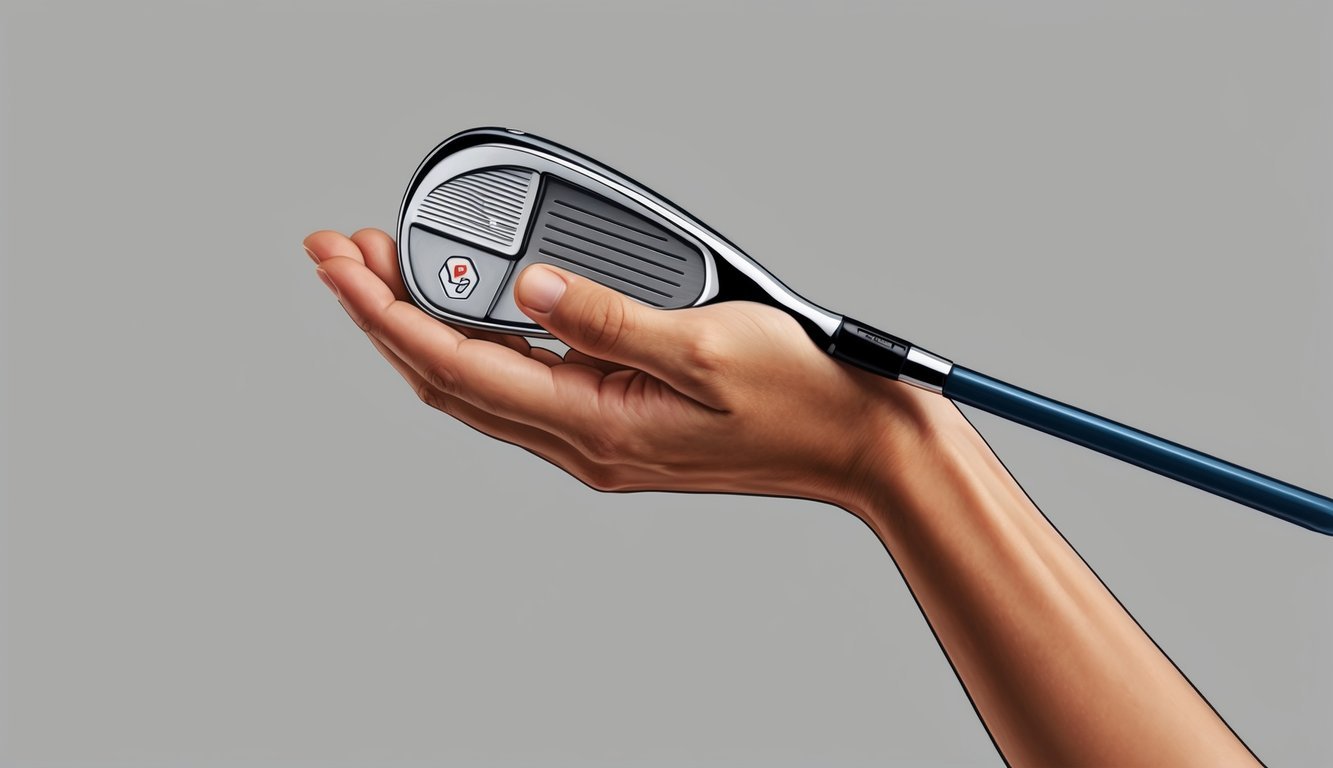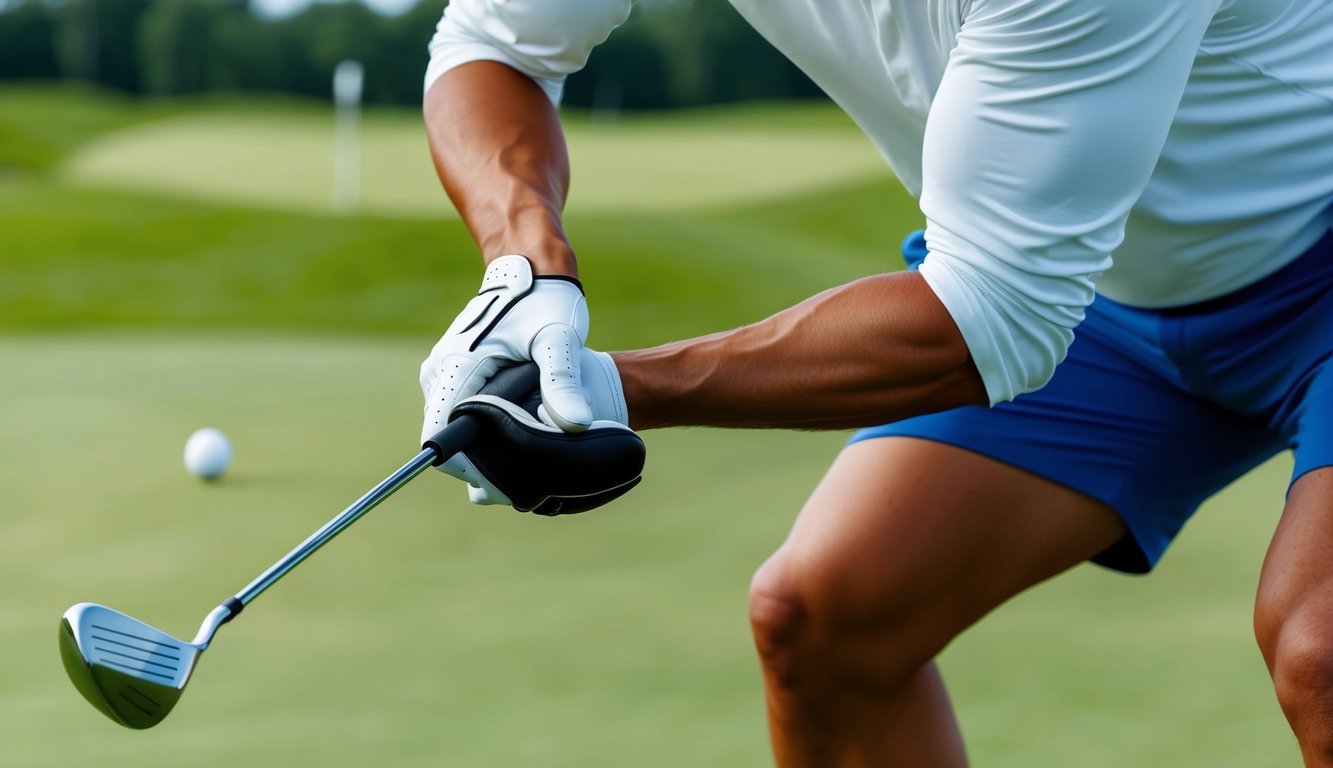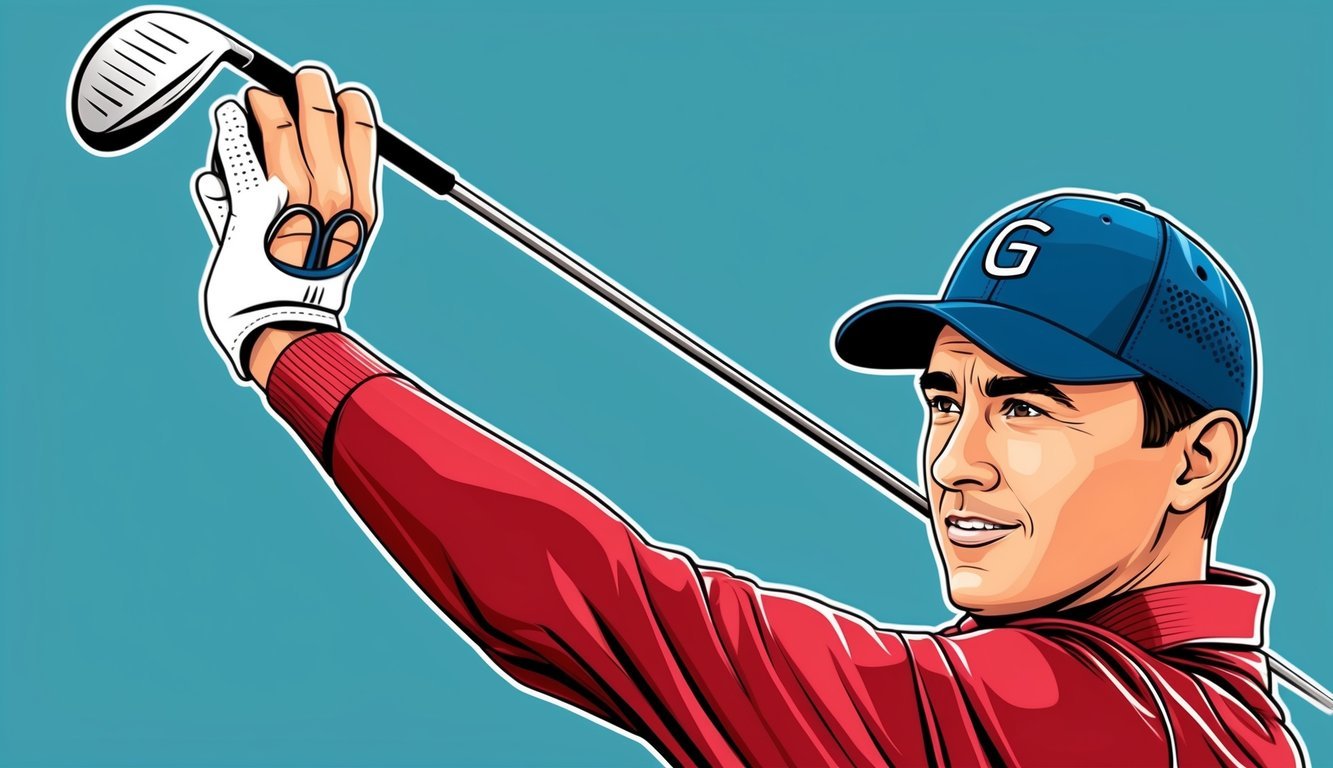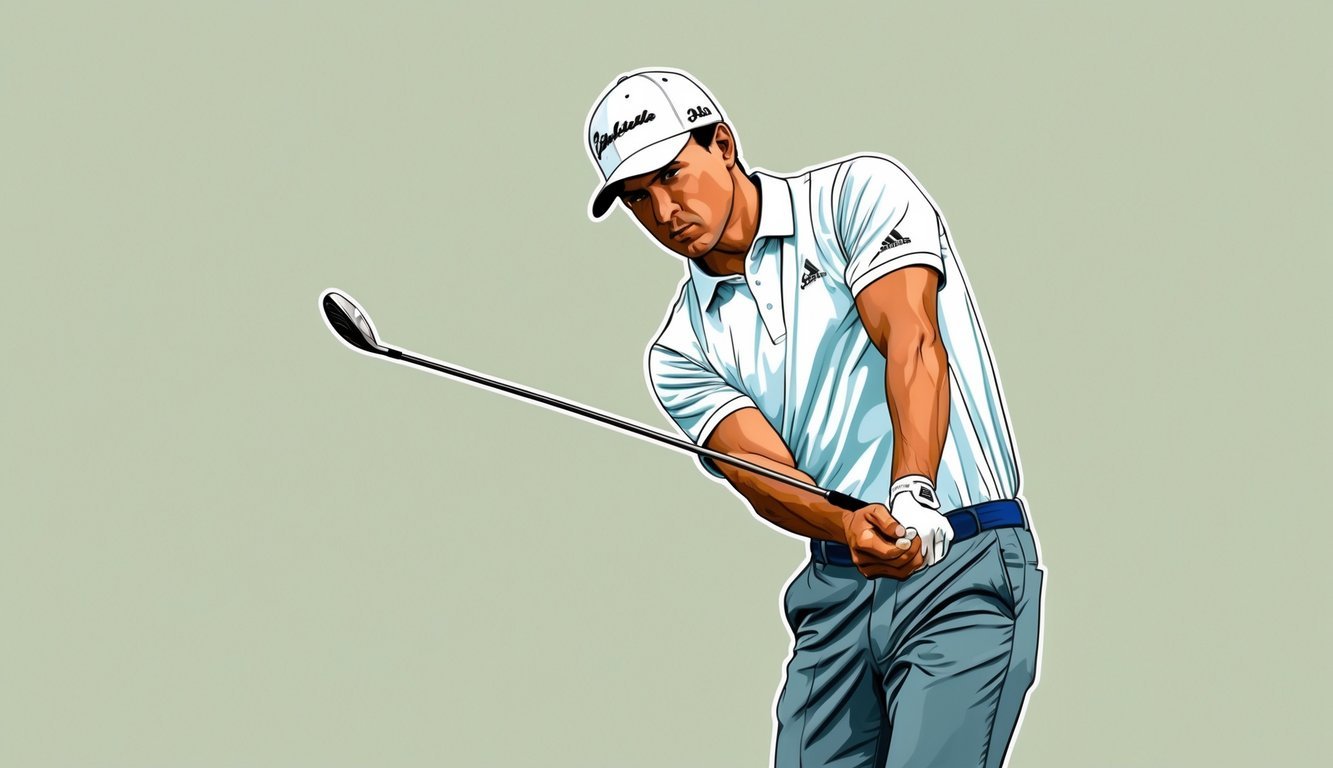Whether you’re an amateur or a seasoned player, you’ve likely experienced the frustration of slicing a golf ball.
A common culprit is the position of your wrists during your swing. Mastering wrist position is key to achieving a straight shot, enhancing both your control and overall performance.

When your wrist is cupped, it can be challenging to maintain a square clubface upon impact.
This can lead to weaker shots and inconsistent ball flights.
By focusing on your wrist position, you can greatly reduce slices and increase your distance on the fairway.
Learning proper wrist techniques can transform your game.
From mimicking the methods of professional golfers to practicing effective drills, you can make significant improvements in your swing mechanics.
Key Takeaways
- Wrist position significantly affects your ball flight.
- Adjustments can lead to more accurate and powerful swings.
- Practice and observation can enhance your technique.
Understanding the Golf Swing Mechanics
To master the golf swing, paying close attention to your wrist movements is essential.
Your wrist’s position impacts the trajectory and power of the shot.
Recognizing how different wrist actions affect your swing dynamics can greatly enhance your performance.
The Role of the Wrist in Swing Dynamics
The wrist plays a critical role in controlling the clubface during your swing.
As you begin the backswing, the position of your lead wrist can dictate the outcome of the swing.
A cupped wrist tends to open the clubface, while a bowed wrist closes it, impacting ball trajectory and distance.
Managing these movements allows for better control during the transition from backswing to downswing, ensuring the clubface strikes the ball squarely at impact.
Your grip also affects wrist action.
Holding the club across your fingers rather than the palm helps maintain a more neutral wrist position.
This balance is crucial for creating a consistent and powerful swing.
Common Wrist Positions and Their Effects
Golfers often encounter various wrist positions like cupped, bowed, and flat during a game.
A flat wrist is typically ideal, promoting a straight club path and reducing errant shots.
In contrast, a cupped wrist can lead to a slice by opening the clubface at the top of the swing, requiring precise timing to correct at impact.
Meanwhile, a bowed wrist encourages a closed clubface, often leading to a more controlled draw.
These wrist dynamics can alter the club’s trajectory, power, and accuracy.
Practicing wrist positions and understanding their impact on your swing can lead to significant improvements on the course.
The Impact of Wrist Positioning on Ball Flight
Wrist positioning plays a crucial role in determining your golf ball’s flight path.
Understanding how cupped and bowed wrists affect the clubface at impact can enhance your control over slices, hooks, and overall ball accuracy.
Cupped vs. Bowed Wrist: Ball Flight Differences
A cupped wrist, or lead wrist extension, occurs when your wrist bends backward.
This wrist position often results in an open clubface at impact, leading to slices.
Slices are characterized by a ball flight that curves excessively to the right for right-handed golfers.
Conversely, a bowed wrist positions the wrist in flexion.
This setup typically creates a closed clubface, promoting a hook.
A hook sends the ball left for right-handed golfers.
The choice between these wrist positions can drastically impact your ball’s trajectory and control.
Adjusting Wrist Positions for Desired Ball Flight
To better control your ball flight, adjust your wrist position during your swing accordingly.
If you’re struggling with slices, aim to reduce wrist extension, allowing for a more square or slightly closed clubface at impact.
This might help in achieving a draw, a controlled curve from right to left.
If hooks are your issue, slightly increase wrist extension to prevent the clubface from closing too much.
Mastering these small adjustments can improve power, distance, and accuracy, helping you achieve more consistent ball striking.
Practice these changes to understand how they affect your gameplay and adjust as needed for the best results.
Drills and Techniques to Optimize Wrist Position

Optimizing your wrist position in golf can greatly enhance your swing and improve your game.
Effective drills and training aids can help you achieve the desired wrist flexion and extension, enhancing your control over the clubface.
Practice Drills for Improving Wrist Flexion and Extension
Using specific drills can effectively improve your wrist flexion and extension.
One key exercise is the half-swing drill, where you focus on maintaining a neutral wrist position throughout the swing’s arc.
Start by practicing with slower swings to ensure proper wrist alignment.
Another useful drill is the impact bag drill, which helps reinforce a flat or slightly bowed lead wrist at impact, preventing cupping.
Strike the impact bag and hold your wrist position to feel the correct extension and flexion.
Incorporating these drills into your practice routine can assist in developing muscle memory for ideal wrist positions, leading to more consistent shots.
Using Training Aids to Enhance Wrist Control
Training aids offer additional support in mastering wrist positions like supination, pronation, and radial deviation, allowing you to keep the clubface square through the swing.
The wrist trainer is designed to help maintain a correct angle throughout your backswing and follow-through by providing feedback when your wrist position deviates.
Another useful tool is the swing analyzer, which provides real-time data on your wrist movement during swings.
This helps you adjust and fine-tune your wrist positions without relying solely on feel.
These training aids can be a valuable addition to your practice sessions, providing visual and tactile feedback to improve your golf swing.
Learning from the Pros: Wrist Techniques in Action

Understanding wrist techniques used by professional golfers can enhance your swing and overall game performance.
These players exhibit unique wrist positions that contribute to their success on the course.
By examining their techniques, you can adapt and improve your own wrist movements.
Analyzing Top Players’ Wrist Positions
Top tour players like Ben Hogan and Tiger Woods have distinct wrist positions that set them apart.
Ben Hogan, known for his precision, uses a bowed left wrist to close the clubface at impact, resulting in consistent, powerful shots.
Meanwhile, Tiger Woods often employs a cupped wrist during his backswing, which helps manage the trajectory and spin of his shots.
Jack Nicklaus and Fred Couples are also notable.
Nicklaus’s slightly cupped wrist helped him control his powerful drives, while Couples’ relaxed wrist action added a smooth rhythm to his swing.
Analyzing these wrist techniques provides insight into how different wrist angles can affect shot-making.
Adapting Professional Strategies to Your Game
Adapting professional wrist techniques requires practice and understanding.
A golf coach or instructor can help you identify which pro’s wrist position complements your current skill level.
For instance, if you admire the way tour players control their iron shots, focusing on a slight wrist flexion like Hogan’s might be beneficial.
When incorporating these strategies, use tools like video analysis to compare your swing to the pros.
Publications such as Golf Digest and advice from a golf instructor can provide further guidance.
Building muscle memory through repetition and experimentation will gradually adjust your wrist position, leading to more consistent and controlled swings.
Advanced Concepts and Adjustments for Regular Golfers

Understanding wrist positioning can significantly improve your golf game.
By making precise adjustments to your grip and wrist alignment, and evaluating your wrist action, you can enhance shot accuracy and consistency.
This section explores how you can refine these elements for better performance.
Fine-Tuning Grip and Wrist Alignment for Consistency
Achieving consistency in your golf swing starts with your grip.
Regular golfers should experiment with different grips, such as a neutral grip, strong grip, or weak grip, to find what works best.
A neutral grip generally offers a balanced swing, while a strong grip might help if you struggle with slicing.
Align your wrists properly.
A slightly cupped or bowed wrist at the top of your swing can affect your clubface angle, leading to hooks or slices.
Observing your stance and setup can ensure your wrist alignment promotes solid contact with the ball.
Evaluating and Evolving Your Wrist Action
Assessing your wrist action is crucial for minimizing inconsistencies.
Pay attention to how your wrist moves through your backswing and follow-through.
Many amateur golfers open the clubface by having a cupped wrist during the backswing, leading to slices.
Focus on achieving a neutral wrist position at the top of your backswing.
Regular practice and adjustments can help you transition from an amateur to a good player.
As you improve, periodically revisit your wrist positioning and grip style to accommodate any changes in your playing style or equipment preferences.

